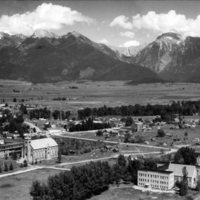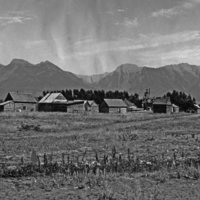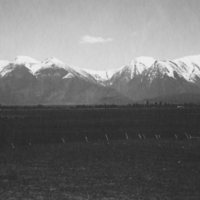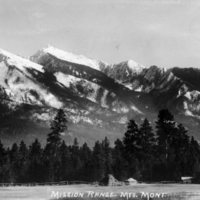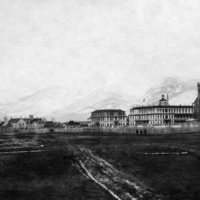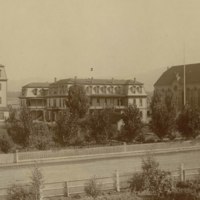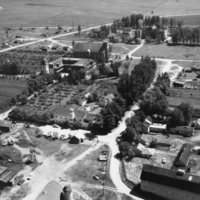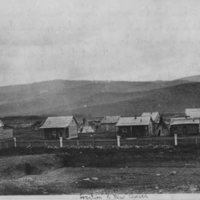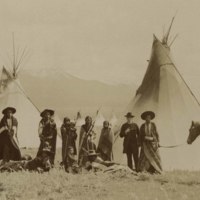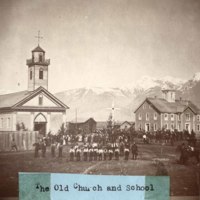The Fated Surroundings
Dublin Core
Title
The Fated Surroundings
Subject
About the Creator:
This project was created, collected, and curated by Daniel Hodge--a Senior English Major from Torrance, CA. My studies revolve around mostly theories involving Race and Gender. In my work, I fought hard to create an honest and accurate portrayal of the experiences on the St. Ignatius Mission based on the materials I was given. It was never my intention to speak for other marginalized groups of people or further silence their experiences. I hope my work was true, honest, and fair. Also, I'd like to note that I hope for my project to spark conversation, further inquiry into the mission, and work to build more projects from it. If you or anyone feels my project does not do that proper work of revealing certain experiences about Mission life, please contact Gonzaga University. Thank you for taking the time to look through my collection.About the Project:
“The Surrounded” project aims to explore a complicated history revolving the colonial arrival of Jesuit Missionaries onto Native American reservations--particularly the Flathead Reservation in Western Montana. All of the images included in the project are photos extracted from the Jesuit Oregon Province Archives (JOPA) at the Foley Center Library, Gonzaga University. Before talking about the project, it’s important to note that the gaze (or scope) of these materials rely heavily on the point of view from the Jesuit Missionaries. In their attempt to document history, these images did not allow for me to discover the viewpoint or opinions of the Indigenous people to the land. Because of this limitation, the only way to present this material with a level gaze was by contextualizing the resources from the archive, with D’Arcy McNickle's novel, "The Surrounded."In a review, one scholar identified McNickle as, "a distinguished anthropologist and writer, and one of the founders of the National Congress of American Indians, the late D'Arcy McNickle was a member of the Confederated Salish and Kootenai tribes of Montana." The inclusion of McNickle's novel drives the leveling scope of this project because historically, the complicated history of these two cultures is often romanticized by the dominant ideology. Without McNickle’s experienced critiques of this ideology, the project would inevitably fail as because of it’s lack of interrogation with both peoples who inhabited the reservation.
The novel takes place on the Flathead Native American Reservation in Montana. McNickle's protagonist, Archilde Leon, goes on a fated journey revealing the complex relationship that developed between the Jesuit Missionaries and the Native American peoples. The novel provides its reader with realistic depictions of reservation life for both the indigenous people to the lands and the Jesuit Missionaries who arrived onto the reservation in the fall of 1854. By providing images and journal entries from historical moments on the Reservation, consumers of my project can then articulate whether the relationship between the two groups was a colonial one, or a intersectional one. With this sudden clash of culture, who was greatly affected?
McNickle initially portrays the black robed priests as white settlers who did not arrive hoping to force the indigenous people to assimilate—but as the novel moves a long, and the Native peoples become more demobilized by the white settlers, McNickle reveals a shift in the relationship between the black robes and the local tribes of the Flathead Reservation. McNickle initially portrays the black robed priests as white settlers who did not arrive hoping to force the indigenous people to assimilate—but as the novel moves a long, and the Native peoples become more demobilized by the white settlers, McNickle reveals a shift in the relationship between the black robes and the local tribes of the Flathead Reservation. As the Native peoples became justifiably more rebellious, McNickle depicts the newer black robed priests as a group of peoples who did not care to entertain the history of indigenous cultures—they became solely focused on forced assimilation. On the opening page of the print based text, McNickle adds a note which reads, "they called that place Sniel-emen (mountains of the surrounded) because there they had been set upon and destroyed."
Description
General Summary of D'Arcy McNickel's Novel, "The Surrounded"(This summary comes as an afterword written by Lawrence W. Towner):
"As 'The Surrounded' opens, Archilde Leon has just returned from the big city to his father's ranch on the Flathead Indian Reservation in Montana. The story that unfolds captures the intense and varied conflicts that already characterized reservation life in 1936, when this remarkable novel was first published. Educated at a federal Indian boarding school, Archilde is torn not only between white and Indian cultures but between love for his Spanish father and his Indian mother, who in her old age is rejecting white culture and religion to return to the ways of her people. Archilde's young contemporaries, meanwhile, are succumbing to the destructive influence of reservation life, growing increasingly uprooted, dissolute, hopeless. Although Archilde plans to leave the reservation after a brief visit, his entanglements delay his departure until he faces destruction by the white man's law."By the end of the novel, Archilde truly understands what it means to be "surrounded" by the mountain ranges, a father, a Jesuit Mission, and government laws. McNickle portrays this as a fated journey that is often given to young Native American children forced to attend federal boarding schools. He does not create a romantic caricature of Native life but rather reinforces the brokenness, the dissonance and alienation Native American children felt during early 20th century reservation life.
*You can find my extended analysis of the novel in the "Exhibits" section.*
Creator
Daniel Hodge
Source
All quotes within this collection come from D'Arcy McNickle's novel, The Surrounded
All resources come from the St. Ignatius Mission Collection, Jesuit Oregon Province Archives.
Rights
McNickle, D'Arcy. The Surrounded. Ed. Lawrence W. Towner. Albuquerque, NM: U of New Mexico, n.d. Print.
Contact the Jesuit Oregon Province Archives, at Gonzaga University, for permission to copy or publish this image.
Collection Items
Birds Eye View of the St. Ignatius Mission
This image captures the mission grounds within the Flathead Reservation and the surrounding Mission Range Mountains can be seen in the background.
Ground Level View of the St. Ignatius Mission
This image captures the front of the St. Ignatius Church and many of the Native American huts that were scattered around the mission grounds.
Snow Covered Mission Range Mountains
In the winter the mountains that bordered the Flathead Reservation were covered with snow and extremely dangerous to navigate during this season.
Landscape View of Mission Range Mountains
Again, the imposing mountains dominate this photograph. In the foreground of the first photo and in much of the second photo you can see a farm-like settlement near the base of the Mountains. This type of settlement was frequently mentioned within…
Landscape view of the New St. Ignatius Mission Church, the Jesuit House, and Old Mission Church
Location Number Description:
1) This is the Old Mission Church first built in 1962 by the original Fathers who established the Jesuit mission in the Mid-1850s.
2) The white building shows the Jesuits quarters. Some classes were taught in this…
1) This is the Old Mission Church first built in 1962 by the original Fathers who established the Jesuit mission in the Mid-1850s.
2) The white building shows the Jesuits quarters. Some classes were taught in this…
The Jesuit House and St. Ignatius Mission Church
Location Number Description:
2) A newer image of the Jesuit house that was built beside the new mission church. In this image you can see the modern landscaping added to the exterior of the grounds.
3) The St. Ignatius Mission Church can now…
2) A newer image of the Jesuit house that was built beside the new mission church. In this image you can see the modern landscaping added to the exterior of the grounds.
3) The St. Ignatius Mission Church can now…
Birds Eye View of the Mission Grounds
Location #4 in the upper right corner was the main school house for young Native American Boys. Many were forced to attend the boarding schools.
The Location of the New Church and the Old Native American Huts.
The text on the back of this image, written by one of the Jesuits, read, “These Indian hits are typical. They are small, but warm and comfortable. One year the [Natives] and [their] friends will cut the logs and haul them from the mts. to the…
Native American Teepees Bordering the Mission Grounds
A close up view of the St. Ignatius Church and its interior walls. Brother Joseph Carignano painted all 58 art pieces covering the inside of the chapel.
The text on the back of the second photo reads: “At Xmas, Easter, and on St. Ignatius day, the…
The text on the back of the second photo reads: “At Xmas, Easter, and on St. Ignatius day, the…
The Old Mission Church
The Old Mission Church can be seen here in a photograph from the late 1800s and artistic depiction from a German journalist. In the artist's depiction, he seems to capture the same photograph (see the men on the bottom left) but rejects to include…

